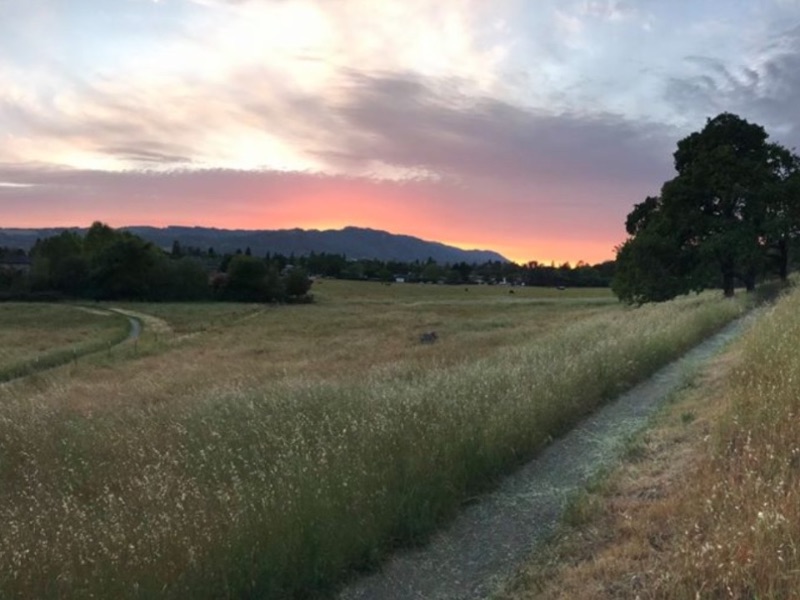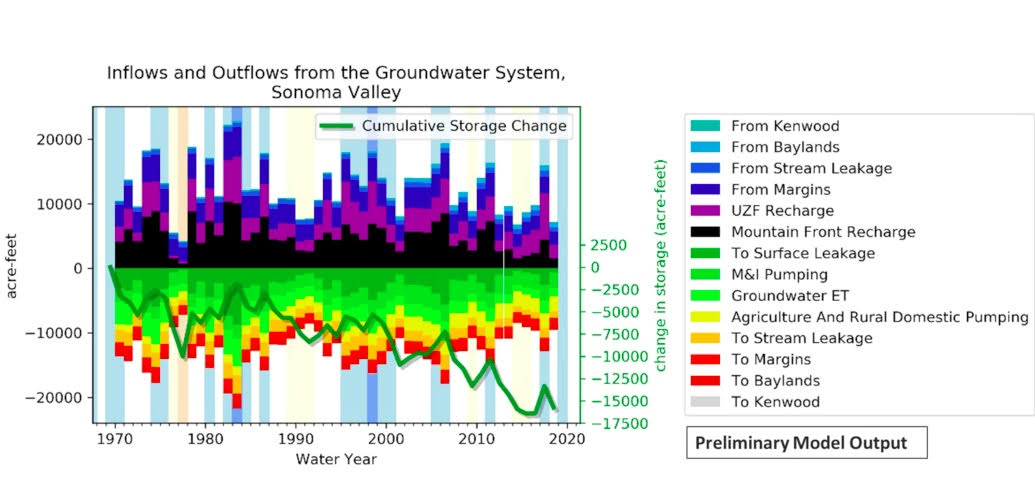Don’t let the late-season rains fool you: this has been another dry year for Sonoma Valley.
Northern California’s 2019-20 rainy season started out strong, but petered out during the holidays. By February, weather watchers were hoping for a “March miracle”—and although Southern California got one, up here in Northern California, “It was, unfortunately, not the miracle we hoped for,” said Napa RCD Senior Hydrologist Paul Blank.
Lighter rains in April and the first half of May have helped a little, but not enough. Even after recent soakings, this season’s rainfall total stands at 15 inches in Sonoma—half the yearly average—and at less than 22 inches as recorded from our weather station at Sugarloaf Ridge State Park.
Inadequate rainfall has two terrible effects: drought and wildfire. Regarding drought, although Sonoma County’s reservoirs are good at this time, the larger trend of declining groundwater levels in Sonoma Valley is not encouraging. This graph, still in draft form from the Sonoma Valley Groundwater Sustainability Agency, shows the declining volume of stored groundwater in Sonoma Valley over 50 years (solid green line). The volume of groundwater is affected over multiple years by inputs of water from rain, the hillsides, and other sources (the dark colors on the top half), and outputs of water such as agricultural and rural domestic pumping, or streamflow south into the Bay (the bright colors on the bottom half). The graph shows that the bottom half is outpacing the top—a trend that needs to be reversed until we are managing this precious store of water in a balanced way.
Regarding wildfire, Sonoma Valley knows about that all too well.
The problem of drought and its consequences is not unique to Sonoma Valley, Sonoma County, or even Northern California. Scientists describe “the first human-caused megadrought,” a climate change catastrophe spanning the past two decades across the entire western United States. Their conclusions are unsettling, except for one key aspect: We still have it in our power to do something about it.
Although we can’t make the rain come, there are lots of things people can do to address drought’s root cause, climate change, and to mitigate its consequences of water scarcity and wildfire.
Climate change: The first and best thing citizens can do to address this global challenge is to vote for leaders who will implement smart policies, such as taxing carbon, approving transit-friendly housing and bike paths, or making it easier to obtain solar panels and electric vehicles. That said, our personal day-to-day choices—what we eat, what we drive—can make a huge difference right now. (Check with Sonoma Clean Power for energy-saving tips and programs.)
Water scarcity: In Sonoma Valley, streamside homeowners are well positioned to help enhance streamflow (which in turn enhances groundwater levels) by capturing water during the rainy season and releasing it slowly over the summer months. Our Streamflow Stewardship Program is helping to implement solutions like these, especially in the upper Sonoma Creek watershed. We’re also studying how groundwater and streamflow interact—collecting data that informs decisions about land and water. Meanwhile, everyone can conserve water in the usual ways, most effectively by using drought-tolerant native plants for landscaping.
Wildfire: All through the spring, our restoration experts have been managing excess fuels—for example, pulling French broom from acres of land, and conducting a prescribed burn at Van Hoosear Wildflower Preserve. At the individual level, homeowners are best positioned to prepare for wildfire by home-hardening and strategic landscaping as described in our “fire smart, water wise and wildlife friendly” landscaping brochure (available on our homepage at www.sonomaecologycenter.org).
The problems are daunting, to be sure. But the solutions are doable. We just have to work together to achieve them.


